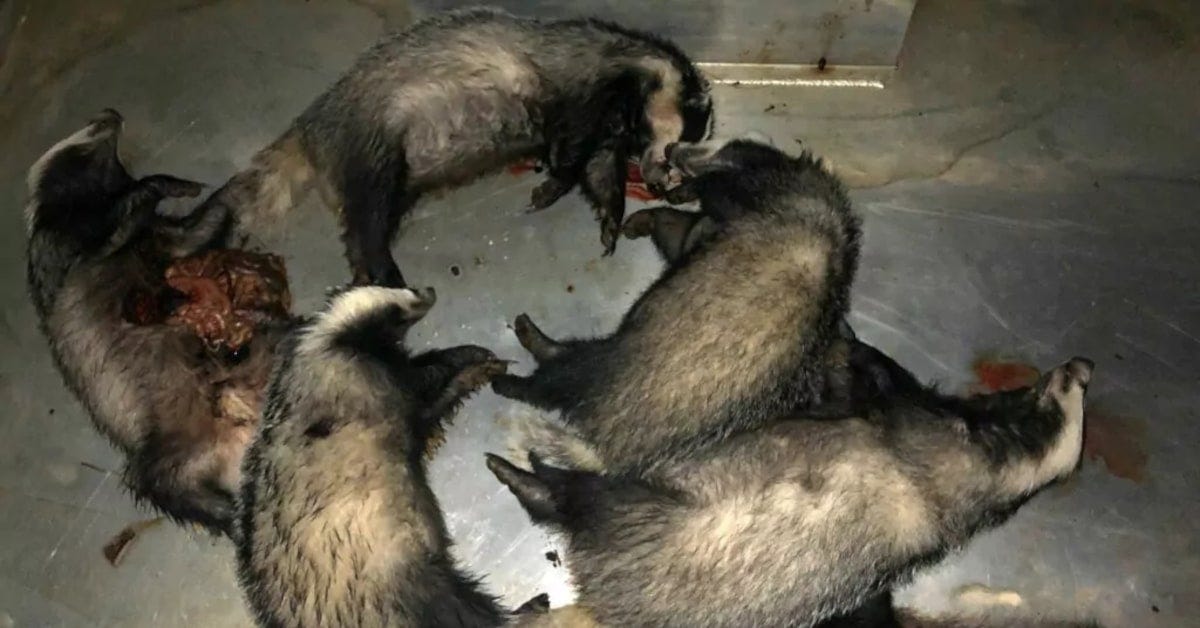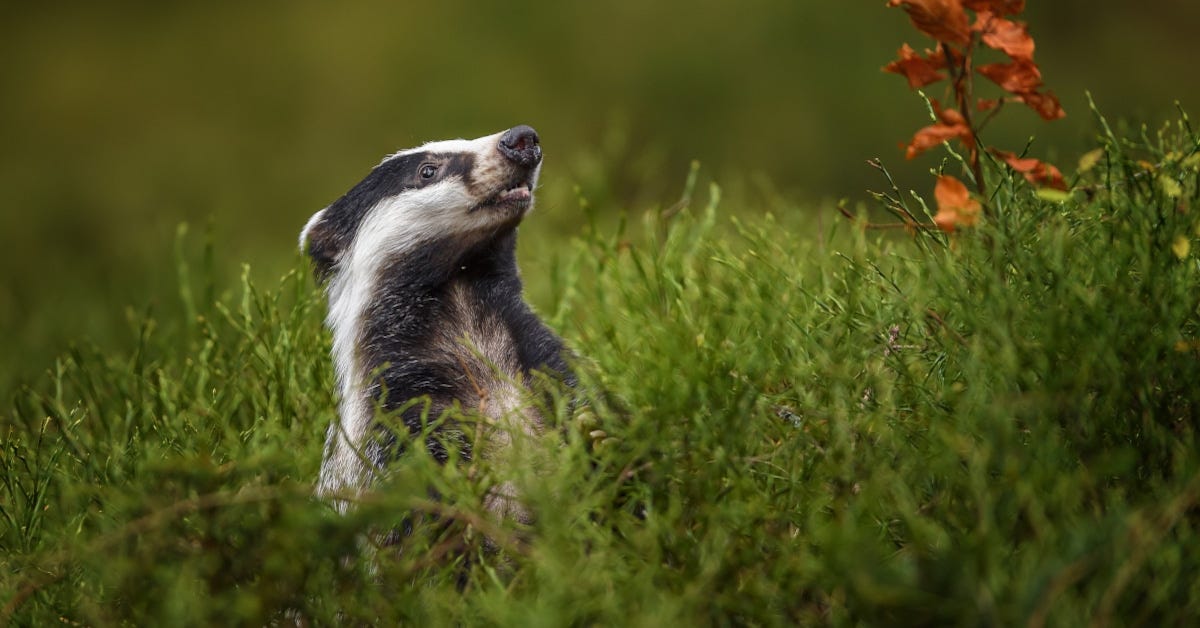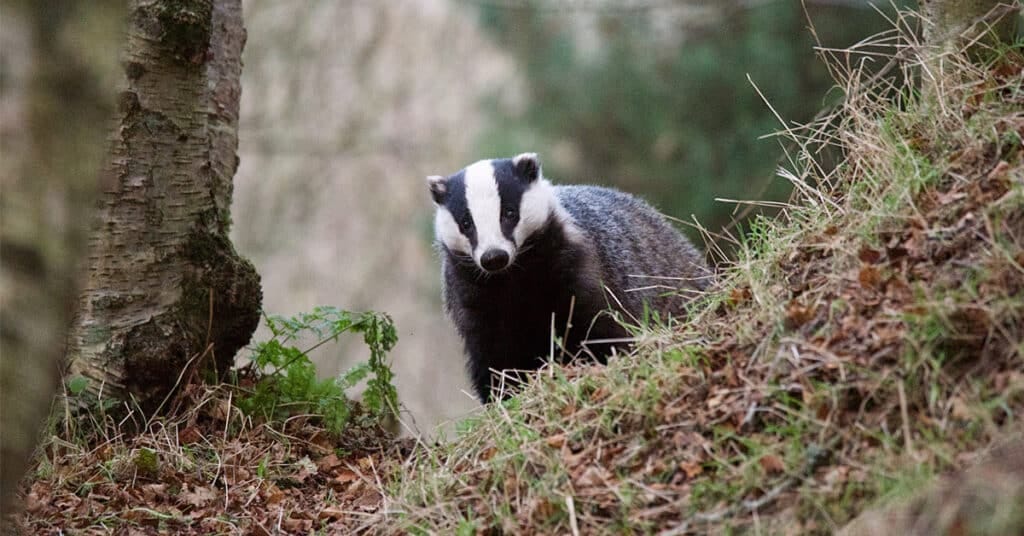UK authorities have permitted badger control operations to take place in England’s nature havens, according to new revelations. Freedom of Information requests involving Natural England, the Forestry Commission, and Forestry England, show that badger control activities, including culling in some instances, have been permitted in various nationally important nature areas since at least 2016.
A decade-long cull
The government’s cull policy centres on the premise that badgers passing bovine TB (bTB) to cows is a considerable issue. As such, it claims that culling is necessary to tackle the disease in farming operations. It has permitted the killing under licence of hundreds of thousands of badgers since 2013, which it says has “led to a significant reduction in the disease.”
An in-depth study in 2022 challenged the government’s argument, however, finding that cow-focused measures, such as increased bTB testing, have likely contributed to reductions in the disease. The study characterised badger culling as having “no discernible impact”.
More recently, a study on bTB transmission dynamics in a Northern Ireland county cast further doubt on the government’s claims. As the Badger Trust’s Peter Hambly pointed out, the study showed that “any [badgers] that do have bTB are 800 times more likely to have caught it from cattle.” He went on to describe the badger cull as the "most toxic wildlife management strategy in Britain’s contemporary history”.
According to ecologist Tom Langton, who was not involved in the study, the Northern Ireland analysis also implies that “cattle to cattle transfer dwarfs any badger to cattle transmission,” providing further evidence that “the bovine TB epidemic is being driven almost entirely by cattle movements, cattle grazing patterns and a failure of the current cattle testing regime.” Langton was the co-author of the 2022 study on the English cull’s limited role in tackling bTB.
Badger control operations in nature havens
Until now, there has been scant information about how culling companies in England have utilised publicly-owned or managed lands in their operations, with farmers and private landowners typically understood to be providing access to land.
In recent years, however, Anna Dale, a concerned citizen and campaigner against the cull, has submitted freedom of information requests on the matter to relevant authorities. Ex-chairman of the Badger Trust David Williams, who has been involved with badger welfare for decades, also submitted a request.
Natural England and Forestry England variously fought release of the information, arguing in part that doing so had security and public safety implications. Natural England, for instance, asserted that revealing the information could lead to protestors identifying the lands in question and targeting staff and organisations operating on them.
Natural England highlighted that staff and volunteers are not involved in badger control work and may have no knowledge that it is taking place.
The agencies have since released some of the requested information, either due to outcomes of internal reviews into the initial responses or decisions by the Information Commissioner’s Office in the wake of complaints by the applicants. Natural England confirmed that 53 National Nature Reserves (NNRs) fell within the boundaries of badger control areas in 2022, in whole or in part. NNRs are the “crown jewels of England’s natural heritage”, according to the NNR partnership, namely the collection of charities and agencies that manage the lands.
Varied activities take place in badger control areas, including surveying, baiting, trapping, and culling. Some 17 NNRs contained land that was accessible for culling as of October 2022, according to Natural England, suggesting that the remaining NNRs within the boundaries of badger control areas were subject to non-lethal control activities.
In response to a request for up-to-date information from Protect the Wild, Natural England confirmed that 13 NNRs contain land accessible for culling in 2023. It did not have updated figures for NNRs that fall within the boundaries of badger control areas this year.
There are some 220 NNRs in England, meaning that almost a quarter of them are now known to have been involved in the badger cull at some stage.
Image taken from our 2022 undercover investigation of the badger cull
Access agreements with cull companies
Additionally, Forestry England confirmed during the freedom of information requests that it had entered into 43 access agreements with badger control companies by March of this year, with the first ones starting in 2016. These agreements involved over 390km2 of land in all.
Forestry England manages vast amounts of the nation’s woodlands, including over 680km2 of land in NNRs and Sites of Special Scientific Interest (SSSIs).
In its freedom of information responses, the Forestry Commission, which sponsors Forestry England, asserted that it did not allow access for culling, only other control activities. In particular, the non-ministerial department said population monitoring and bait point activity, namely drawing badgers onto land where they can be culled, took place. However, Forestry England subsequently provided a copy of the agreement it uses for all such arrangements, which lists surveying, baiting, trapping, and dispatching badgers, among the core purposes.
Forestry England has since clarified to Protect the Wild that it is up to license holders, meaning cull companies, to decide which of the listed activities they want to request permission for. The agency indicated that it may permit the companies to carry out any of them, provided they meet certain terms and conditions. However, Forestry England said it does not hold information on culling happening, which companies would be obliged to provide under the agreement conditions, and therefore no such lethal measures have taken place.
The agency also confirmed that there are currently 42 active agreements, compared to 43 at the time of the freedom of information requests.
A Forestry England spokesperson said:
We understand the importance of the bTB control policy and, as a Government Department, when land we manage falls within badger disease control licence areas, we work with Natural England, Defra and other landowners to implement Government policy.
We handle requests from applicants for a Natural England licence in the same way we do for all other requests to access land we manage. If we give permission it does not automatically mean badger disease control activity would be carried out on land we manage and public safety will remain paramount.
Forestry Commission employees do not carry out any badger disease control activity.
We are committed to nature conservation management in the nation’s forests and have a long history of working closely with conservation groups.
“Extremely worrying”
Responding to the findings, retired government scientist Dr Chris Cheeseman, who worked on bTB in badgers and cows for 32 years, says:
“I find it extremely worrying that these two public bodies have sought to accommodate the government’s controversial badger culling policy by allowing access to land in which the public has a direct interest. The practice of luring badgers with bait onto adjacent land where they can be trapped and killed is particularly abhorrent.”
Cheeseman also raised concerns over badger sett information that may be held by these bodies for the relevant lands ending up in the hands of cull companies.
Protect the Wild asked the agencies whether they provided any data held on badgers to cull companies operating on the lands they manage. Natural England indicated it does not share such information with any third parties. Forestry England said it has no information showing that it does share this sort of data with cull companies, thus the answer is “no”.
Natural England oversees around two-thirds of NNRs, which are centred on ‘three pillars’: conservation, research, and access. Dorset Council, a county where badger culling has taken place, has explained that although the public has access to NNRs, people “must be careful not to damage the wildlife of these fragile places” because they are areas where “wildlife comes first.”
Guidance on signing up NNRs
The Freedom of Information requests revealed that Natural England produced guidance for badger licence control applicants on signing up NNRs. Natural England failed to provide a copy of this guidance in the freedom of information requests, again citing a risk to public safety. It has since confirmed to Protect the Wild that the guidance does not identify which NNRs are signed up for badger control operations, suggesting that public knowledge of its contents would no more enable protestors to identify the sites than other information revealed through the requests.
Natural England also provided some details on the criteria for signing up NNRs. Sign-ups happen on a case-by-case basis, dependent on different factors. These can include whether badgers are present, what access the public has to the site, and how close grazing cows are to the area.
A Natural England spokesperson said:
“Bovine TB is one of the most difficult and intractable animal health challenges the livestock sector in England faces today, causing considerable trauma for farmers and costing taxpayers over £100 million every year.
“As both the wildlife licensing authority and Government’s nature conservation advisor, our job is to ensure that the Government’s policy on badger culling and vaccination is implemented effectively and with full regard to the impacts on nature conservation.”
UK wildlife in jeopardy
The revelations follow the release of a comprehensive report about the state of nature in the UK. Compiled by the State of Nature Partnership, a coalition of environmental organisations, the analysis showed that one in six species in Great Britain are at risk of extinction, including twenty-six per cent of its terrestrial mammals.
Badgers are a protected species in the UK and play an integral ecological role as the country’s largest remaining mammalian land predator. Ecological consultant Dominic Woodfield, who previously produced a review of Natural England’s assessment processes related to cull licensing, has warned of the risk that the cull poses to wildlife:
“While successive Governments and their advisors have repeatedly acknowledged the potential for badger culling to have collateral negative impacts on other wildlife, including protected species, neither Defra nor Natural England have sought to investigate the issue with any scientific rigour. Preventative measures to combat that risk are only applied in a proportion of protected sites, leaving much of the wildlife of western England devoid of any such protection.”
Cheeseman also warns that:
“Draconian culling of a “Key” species is likely to have a profound effect on some other species in the ecosystem. Reports from areas where culling has taken place reveal that badgers have now been totally eliminated in many locations.”
As outlined in a policy paper, the government asserts that it sets varying limits on the maximum number of badgers allowed to be killed in any given area so as “not be detrimental to the survival of the population concerned.”
“The badger culls are a travesty”
Natural England released figures for further licensed culls this autumn, permitting up to 29,000 more badger killings. If this level of culling is achieved, the total death toll since rollout could exceed 260,000 badgers, over half of Britain’s estimated badger population.
In 2021, the government announced it would be phasing out the cull. According to the timeframe, four-year-long intensive culls are set to cease in 2026. However, culling appears unlikely to end as officials are considering pursuing a policy of so-called ‘epidemiological’ culling. As The Independent reported, rural affairs minister Richard Benyon explained in a letter that, alongside vaccinating badgers against bTB, the policy would allow culling to continue “on a targeted basis, where epidemiological evidence suggests this is appropriate.”
In May, Langton produced a report on the subject with a team of scientists, epidemiologists, and veterinarians. Examining trials of epidemiological culling that have already taken place in England since 2018, it concluded that the scientific evidence to support this approach is not “sufficiently robust to justify veterinary approval for any wider use.” The report further said:
“Until the belief in the role of badgers in the spread of bTB is broken, substantial progress with bTB elimination in England will continue to be severely hampered.”
Cheeseman points out that the government has made no attempt to estimate the prevalence of TB in badgers, despite the cull generating hundreds of thousands of their dead bodies that could be tested as part of the policy. The retired government scientist concludes:
“The badger culls are a travesty instigated by a government that purports to be a guardian of our natural heritage… It is a purely political policy and has to stop.”
Featured image via Charlie Marshall / Flickr
Protect the Wild campaigns to end the badger cull
Protect the Wild vehemently opposes the badger cull, a practice we consider inhumane and scientifically unjustified. Our stance against this cull was further reinforced in 2022 when we released shocking undercover footage of disturbing incidents involving cull contractors at Grafton Pet Crematorium in Northamptonshire. These videos, captured in September and early October, revealed the grotesque reality of the badger cull, which the government claims to oversee with the strictest biosecurity measures. The footage exposed a blatant and consistent disregard for potential biohazards and disease transmission. This disturbing revelation raised concerns about the extent of recklessness and non-compliance with crucial regulations throughout the UK.
If you share our commitment to exposing and ending the cull, consider supporting our efforts by adopting a badger with us. It's an impactful way to contribute to our work and help us continue to shed light on this critical issue.












It has been known for many years that cattle give TB to badgers and unlikely vice versa. Badgers turn over cow pats to feast on worms etc, cattle are unlikely to eat grass at a latrine. Farmers and land owners need little excuse to kill if they can, it's their hobby after all! As for 'English Nature' it has always been just a group of land owners who want to be in control of land wherever it is in the country, it expands personal interests and does not allow the 'natural' to get in its way! I'm not a fan of bodies who proclaim to be conservationists. They seem to be made up of the very people who push our wildlife to the brink of existence then rush in to save it claiming 'conservation'! Not all of the groups are like that I know but I do wish we could leave Nature alone a bit and stop so much interference!
Slowly, but very surely, the truth behind this corrupt tory "government's " continued badger killing is beginning to emerge - so very sadly, this senseless slaughter has cost a QUARTER OR A MILLION of Brock's Clan their lives. As soon as the corrupt tory cabal fall at our next General Election we must demand a full independent public inquiry of corruption, collusion & incompetence within both Defra (aka Deathra) AND Natural England (aka UNnaturalEngerland) So heartening to see a Labour Party commitment to ending the abhorrent badger kill/cull. We must ALL ensure this happens asap once the tories fall - AND hold those responsible to account. Indeed, a complete BAN on all bird shooting bloodsports would be a fitting legacy to tory "govt" badger killing - such a ban, would, in turn, save hundreds of badgers & countless other wildlife...